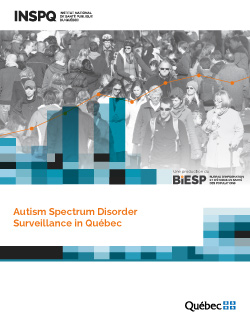Autism Spectrum Disorder Surveillance in Québec
This report discusses the prevalence and the incidence rate of autism spectrum disorder (ASD). It also demonstrates the capability of the Québec Integrated Chronic Disease Surveillance System (QICDSS) to identify the comorbidities associated with ASD and the profile of health services utilization. These estimates were obtained from a longitudinal study covering the period from April 1, 2000, to March 31, 2015, for all persons eligible for health coverage between the ages of 1 and 24 years. To be considered to have ASD, the individual must have had at least one medical visit or hospitalization with a principal diagnosis of ASD.
- The results show a constant growth in ASD over time. In 2014-2015, there were nearly 17 000 persons in Québec between the ages of 1 and 17 who have been diagnosed with ASD.
- The prevalence of ASD varies considerably from one region to another, varying from 0.7% to 1.8% among persons aged 4 to 17 years.
- The lifetime prevalence measured by the QICDSS (1.4%) is relatively close to that of the Ministère de l’Éducation et de l’Enseignement supérieur (1.3%), making it possible to use linked medical and administrative sources to track ASD.
- The material disadvantage index does not show a clear relationship with the prevalence of ASD while the social disadvantage index suggests a linear increase in the rate of prevalence of ASD going from the very advantaged to the very disadvantaged.
- The study of concomitant physical and mental illnesses during the first year of life and throughout life indicates, in general, a greater prevalence in persons with ASD when compared to the general population without ASD.
- Pediatricians and psychiatrists are the medical professionals most often consulted by persons with ASD. The types of professionals consulted change depending on the age of the person with ASD. The study of the hierarchical profile of the services used reveals that, with the passage into adulthood, specialized services for mental health decrease and are provided by family doctors.
- With 75 deaths observed over a period of 15 years, the mortality rate among persons with ASD is three times higher than in the general population without ASD.
The information contained in this report provides an unprecedented view of ASD in Québec based on the new monitoring indicators developed under the framework of the QICDSS and offers many new paths for future research. These include, notably, the exploration of the etiology of ASD, the higher mortality observed with this disorder, and the study of the variation in health services availability and the prevalence of ASD.


